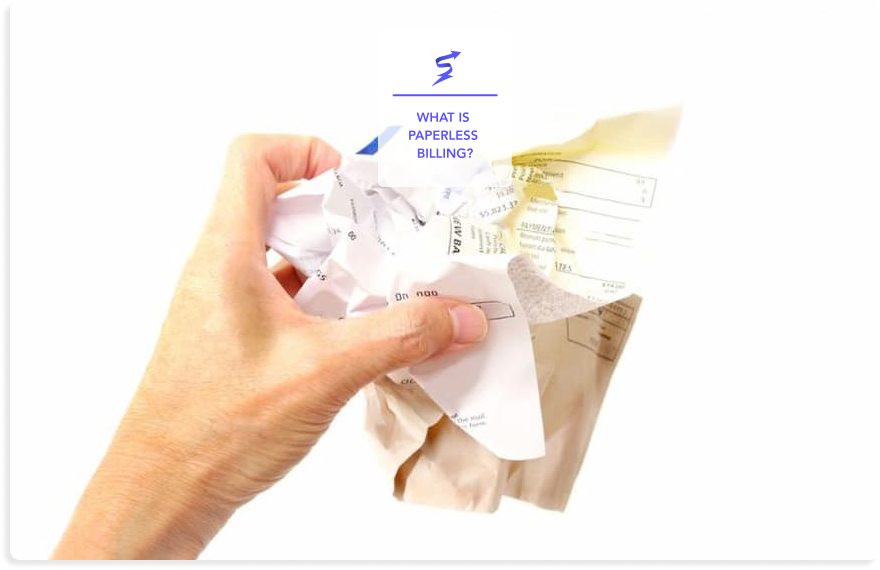Paperless billing: everything you need to know

Are you ready to make the switch?
Switching energy suppliers has never been easier. Simply let our experts cater to all
of your gas and electricity needs.
Notice
Paperless billing has been around for a while, but has become commonplace and, often, the default and preferred option for residential and business energy suppliers alike in 2021. While going paperless certainly has its perks, there are a few things to consider when asking yourself ‘Should I switch to paperless billing?’. In fact, it's important for understanding your utilities well. In this article, we take a look at what paperless billing is, how to switch, how to opt-out and whether or not it’s right for you.
Last update: November 2022

Paperless billing simply means receiving your monthly, quarterly or annual bills online or via email, instead of through your letterbox. Not only applicable to your energy supplier, most utilities now offer a paperless billing service including: council tax, landline and mobile phones, broadband and TV providers.
Does my energy supplier offer paperless billing?
Not only do the large majority of energy suppliers offer paperless billing, some of them even incentivise their customers to opt-in to receiving online bills by providing discounts on their energy tariffs.
Below, we’ve created a table of ten of the largest and most popular UK energy suppliers this year, and whether or not they offer their customers the option to go paperless.
| Company name | Option to go paperless? |
|---|---|
| British Gas |
Yes
|
| EDF Energy |
Yes
|
| E.ON |
Yes
|
| Npower |
Yes
|
| Scottish Power |
Yes
|
| SSE |
Yes
|
| Octopus Energy |
Yes
|
| Bulb Energy |
Yes
|
| Ebico |
Yes
|
| Pure Planet |
Yes
|
Should I switch to paperless billing?
It’s up to you and your personal circumstances whether or not you switch to paperless billing. Some households find it more convenient, where others prefer to see a written paper statement delivered to their homes in letter form - sometimes, this works as a payment reminder for those who pay their bills manually. Bear in mind, both options provide exactly the same level of detail and information - so this won’t be sacrificed if you decide to make the switch to online billing.

Looking for the best energy deals?
Free Service
Request a callback from our experts at Switch Plan to help you find
the best energy contract .
More info
There are a range of pros and cons to paperless billing, which we’ll take a look at below.
Pros and cons of paperless billing
To help you make your decision whether or not to switch, here are some of the benefits and drawbacks of getting your bills online.
First of all, the pros of paperless billing…
- The volume of information and frequency is the same, although paperless bills will be available marginally sooner, because you won’t have to wait for the postman
- Going paperless can help you save money on your energy bills with some suppliers
- Your payment method won’t change; you can pay online or over the phone either way
- Less mail and paper clutter at home, saving the environment along the way
- Generally easy to access from home or mobile device
- Can still be printed if you need a paper copy.
And some cons…
- You’ll need internet access and to create an online account to access your paperless bills
- Sometimes bills are only stored for a year, meaning some charges may be incurred if you need to go back further than that
- If you pay your bill manually, it’s easier to miss an email than it is to miss a letter
- Paperless billing might mean that you forget to check statements as regularly as you would if they came in the post.
Ultimately, it’s down to you whether or not paperless billing works for you!
How to go paperless?
While the method of going paperless varies between providers, there is (generally) a similar process for switching to paperless billing. This usually involves the following steps:
- Registering for or logging into your online account
- Activating or requesting paperless billing
- Confirming your email address
If your energy provider doesn’t currently have this option online, get in touch with them to activate your new billing plan.
How to opt-out of paperless billing?
Opting out is sometimes not as simple as opting in! While many energy suppliers allow you to de-register from paperless billing from your online account, some require you to get in touch with their customer services team to opt-out. Although it doesn’t take long, check the requirements from your energy provider to confirm their process.
Read more:
Looking for a better energy deal?Leave your phone number to request a call back from us!
Free Service
FAQ
Is it easy to switch to paperless billing?
Generally, yes! Of the energy providers that promote and encourage paperless billing, the large majority have a very simple process that involves logging in to your account, activating the paperless billing setting and confirming your email address.
Other energy companies will require you to get in touch with their customer service team on live chat or by phone to activate paperless billing on your account.
Is paperless billing a good idea?
Paperless billing has its pros and cons, but the main positives of switching include cost savings, reducing paper clutter and reducing your impact on the environment made by the use of paper, envelopes, printing and postage.
Is paperless billing safe?
Yes, your paperless bills are held in your secure online account with your energy provider which will require a username or email address and password to access. Making payments online is also very secure, with energy providers using SSL and security features to protect your billing information and sensitive data.
What if I don’t receive my paperless bill?
In the unlikely event that you don’t receive your bill (as it is, of course, automated), get in touch with your energy supplier’s customer service team to confirm its whereabouts. You should receive your energy bill on the same date every month, or slightly earlier if it falls on a bank holiday or a weekend.
Updated on 29 Jan, 2024
Alexander Striano
Consumer Energy Expert
Alex joined the papernest team as a SEO Project Manager Assistant for Broadband Plans. He has developed a real expertise on connectivity topics and works on delivering the best possible content to help you navigate your broadband in and outside your home.
Alex joined the papernest team as a SEO Project Manager Assistant for Broadband Plans. He has developed a real expertise on connectivity topics and works on delivering the best possible content to help you navigate your broadband in and outside your home.
Comments